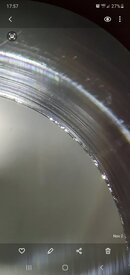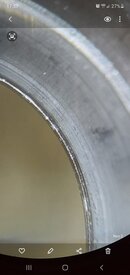The D300/350/400 second stage is one of Scubapro’s premier designs. With its coaxial diaphragm and exhaust valve, it breathes the same in virtually any diving position, unlike regulators that get stiff when you roll on your back and look up (G260), or breathe wet when you go inverted (Scubapro Pilot, Air 1, and in fact, most standard case designs).

Its only shortcoming is an exhaust valve that is slightly smaller than Scubapro's newest designs, slightly increasing Work Of Breathing (WOB) at depths where air density begins to play a role (over 95’/air density >5 g/l). But its center-balanced poppet can be tuned to very low cracking effort, and the short air path from poppet to mouthpiece makes for huge air delivery.
Unlike the "gold standard" servo-assisted center-balanced poppet of the famous Scubapro Pilot here:

the D-series center balanced valve has only three moving parts, and performs almost as well.
In fact, the center-balanced design is so much better than other standard end-balanced barrel regulators that Scubapro reintroduced the center-balanced poppet this year with the D420. That regulator, discussed at great length here: D420! How about that?, simplified assembly and improved WOB even further, but eliminated one feature. Servicing became immeasurably easier, but the coaxial diaphragm was sacrificed in favor of a larger exhaust valve. Thus, total WOB decreased and breathing became even easier in the standard diving position, at the price of a return to slightly stiffer cracking when on your back.
But for some divers (photographers and others who like to peer under ledges), the superb breathing when inverted or on your back, plus near-effortless cracking effort all the time, makes the original D-series a regulator they don’t want to let go. And that brings us to service. Service kits are still being made! But this regulator is HARD to disassemble, finicky to reassemble, and the rarity of a center-balanced design means that some of what you learned when tuning a G250 doesn’t quite apply.
So let’s tackle this regulator. There are three small and two larger challenges: 1) getting the cover off, 2) removing the lever hex screw, 3) reattaching the Pre-Dive switch and lever spring, 4) reattaching the diaphragm cover ring and 5) tuning the lever and poppet. We’ll leave restoring a nicked knife edge to a D-series Restoration thread to follow.
This discussion uses the attached schematic wherever possible. Numbers in parentheses are diagram numbers from that schematic. Any deviations (e.g. the final D-400 model with a new housing and polymer orifice) will be described separately.
Required Tools:

Forceps or surgical clamp
Small flat blade screwdriver
Brass spade
Brass pick
Pin wrench – custom tool Tool for Scubapro D-Series Second Stages , or
- Scubapro tool Scubapro Multi-Tool, Brass Chrome or
- small pin face spanner Face Spanner, replaceable pins (with 0.066" pins).
Wire claw small parts retriever – critical for PreDive switch ass’y www.mcmaster.com PN 5681A22
Three hex keys: 3.5mm, 3/32” and possibly 2.5mm
Spoon with smooth edged handle
Two needle-nosed pliers, if spring bending is required
Challenge #1: Cover removal
Removal of the cover was no big deal when the D300 was introduced. The rubber was soft and supple. Over the last 35 years however, the rubber has gotten harder and less pliable. It’s amazing that it doesn’t just crack and tear when you remove the cover, but that is a rare event. Cracking in the thin skirt at the back of the regulator is the worst that’s usually seen.
(EDIT 6/2022) NEW "FIRST STEP": Leave the hose on! It'll serve as a handle against which you can pull in a step below.
First, slip a brass spade under the cover in back. Sliding it sideways will break any seal.

Now soak the whole reg in HOT water for 5 minutes. Use water as hot as you can stand with your hand; not boiling. Don’t leave it in too long, or you’ll fade the black color of the case.
Once the rubber cover softens, insert the spade in the front of the case at a 45 degree angle to the gap between the case at the bottom of the predive switch. Pry up the thick top of the cover front.

WARNING: It is very easy to jab a hole in the diaphragm if the probe is inserted too far!
After prying up the front corner of the cover, using your third hand, slip the flat blade of a cheap spoon handle, or the bowl of the spoon itself into the gap between the case and the thick cover. Make sure the PreDive switch is in “Pre” to be up and out of the way. Pry the spoon/handle back until you can see the top edge of the diaphragm cover ring. The smooth "shim" of a spoon handle keeps you from gouging the case.


Here's the frustrating part: while holding the cover front pried up with the spoon/handle with one hand, grab the cover by both exhaust holes with your other hand and pull down from one side or the other until the cover comes off. A tool that fits in the exhaust holes would be easier, but anything longer than your fingertip will put a hole in the diaphragm. I’m open to ideas for DIY tools that will make this easier. Try not to swear when it takes four tries, as the pried-up front slips back down over the cover ring, and you have to start over. Now wipe off the sweat, have a beer, and come back later when your fingers stop aching.
(Discussion continued in next post...)
Its only shortcoming is an exhaust valve that is slightly smaller than Scubapro's newest designs, slightly increasing Work Of Breathing (WOB) at depths where air density begins to play a role (over 95’/air density >5 g/l). But its center-balanced poppet can be tuned to very low cracking effort, and the short air path from poppet to mouthpiece makes for huge air delivery.
Unlike the "gold standard" servo-assisted center-balanced poppet of the famous Scubapro Pilot here:
the D-series center balanced valve has only three moving parts, and performs almost as well.
In fact, the center-balanced design is so much better than other standard end-balanced barrel regulators that Scubapro reintroduced the center-balanced poppet this year with the D420. That regulator, discussed at great length here: D420! How about that?, simplified assembly and improved WOB even further, but eliminated one feature. Servicing became immeasurably easier, but the coaxial diaphragm was sacrificed in favor of a larger exhaust valve. Thus, total WOB decreased and breathing became even easier in the standard diving position, at the price of a return to slightly stiffer cracking when on your back.
But for some divers (photographers and others who like to peer under ledges), the superb breathing when inverted or on your back, plus near-effortless cracking effort all the time, makes the original D-series a regulator they don’t want to let go. And that brings us to service. Service kits are still being made! But this regulator is HARD to disassemble, finicky to reassemble, and the rarity of a center-balanced design means that some of what you learned when tuning a G250 doesn’t quite apply.
So let’s tackle this regulator. There are three small and two larger challenges: 1) getting the cover off, 2) removing the lever hex screw, 3) reattaching the Pre-Dive switch and lever spring, 4) reattaching the diaphragm cover ring and 5) tuning the lever and poppet. We’ll leave restoring a nicked knife edge to a D-series Restoration thread to follow.
This discussion uses the attached schematic wherever possible. Numbers in parentheses are diagram numbers from that schematic. Any deviations (e.g. the final D-400 model with a new housing and polymer orifice) will be described separately.
Required Tools:
Forceps or surgical clamp
Small flat blade screwdriver
Brass spade
Brass pick
Pin wrench – custom tool Tool for Scubapro D-Series Second Stages , or
- Scubapro tool Scubapro Multi-Tool, Brass Chrome or
- small pin face spanner Face Spanner, replaceable pins (with 0.066" pins).
Wire claw small parts retriever – critical for PreDive switch ass’y www.mcmaster.com PN 5681A22
Three hex keys: 3.5mm, 3/32” and possibly 2.5mm
Spoon with smooth edged handle
Two needle-nosed pliers, if spring bending is required
Challenge #1: Cover removal
Removal of the cover was no big deal when the D300 was introduced. The rubber was soft and supple. Over the last 35 years however, the rubber has gotten harder and less pliable. It’s amazing that it doesn’t just crack and tear when you remove the cover, but that is a rare event. Cracking in the thin skirt at the back of the regulator is the worst that’s usually seen.
(EDIT 6/2022) NEW "FIRST STEP": Leave the hose on! It'll serve as a handle against which you can pull in a step below.
First, slip a brass spade under the cover in back. Sliding it sideways will break any seal.
Now soak the whole reg in HOT water for 5 minutes. Use water as hot as you can stand with your hand; not boiling. Don’t leave it in too long, or you’ll fade the black color of the case.
Once the rubber cover softens, insert the spade in the front of the case at a 45 degree angle to the gap between the case at the bottom of the predive switch. Pry up the thick top of the cover front.
WARNING: It is very easy to jab a hole in the diaphragm if the probe is inserted too far!
After prying up the front corner of the cover, using your third hand, slip the flat blade of a cheap spoon handle, or the bowl of the spoon itself into the gap between the case and the thick cover. Make sure the PreDive switch is in “Pre” to be up and out of the way. Pry the spoon/handle back until you can see the top edge of the diaphragm cover ring. The smooth "shim" of a spoon handle keeps you from gouging the case.
Here's the frustrating part: while holding the cover front pried up with the spoon/handle with one hand, grab the cover by both exhaust holes with your other hand and pull down from one side or the other until the cover comes off. A tool that fits in the exhaust holes would be easier, but anything longer than your fingertip will put a hole in the diaphragm. I’m open to ideas for DIY tools that will make this easier. Try not to swear when it takes four tries, as the pried-up front slips back down over the cover ring, and you have to start over. Now wipe off the sweat, have a beer, and come back later when your fingers stop aching.
(Discussion continued in next post...)






